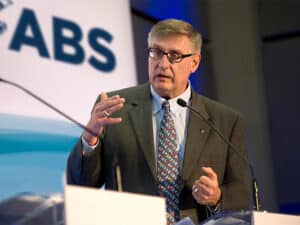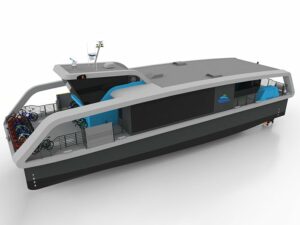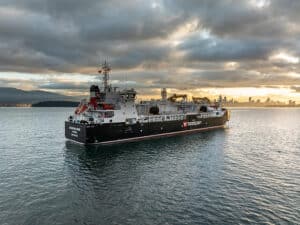
Op-Ed: Shipping’s net zero future needs sharper signals, soon
Written by
Dominik Schneiter
By Dominik Schneiter, CEO, WinGD
The IMO’s Net Zero Framework (NZF) represents a pivotal moment in marine decarbonization, charting a route toward Net Zero by 2050. But is it enough? WinGD’s CEO, Dominik Schneiter, says without strong incentives and clearer rules, the decarbonization course risks drifting.
The IMO’s NZF is the first global framework to combine mandatory emissions reduction targets with greenhouse gas (GHG) pricing across an entire industry sector. Setting a compass reading for net zero by or around 2050, the framework’s GHG Fuel Intensity (GFI) standard and pricing mechanism takes a carrot-and-stick approach to incentivize early clean fuel adopters.
WinGD fully supports these goals, and we’ve developed the engine technology to help shipowners make an early transition to clean fuels and meet their sustainability goals. We know that without effective incentives to drive this transition, everyone stands to lose—not only those investing in clean fuel production, enabling technologies and compliant vessels, but also future generations that will inherit an increasingly uninhabitable planet.
The cost of delay: why clarity can’t wait until 2027
That’s why we’re pushing for greater clarity from the IMO so that our customers can invest with confidence. There is no time to waste. The proposed financial reward for vessels using zero or near-zero (ZNZ) emission energy sources has yet to be priced—its value (or possibly several values, or a calculation methodology) will be set by 1st March 2027, just nine months before the rules come into effect.
This creates a blind spot for shipowners, who must make long-term investment decisions while navigating the significant cost gap between conventional and ZNZ fuels. Price the reward too low and operators may find it makes more commercial sense to ‘pay to pollute’ instead.
WinGD believes a decision is needed far earlier to give energy providers sufficient run-in time to scale up ZNZ fuel production and for ship operators to make their fuel decisions and plan investments accordingly.
Outdated emissions factors: a brake on innovation
There are further blind spots in the proposed NZF, not least a failure to recognize how quickly fuel and engine technology is evolving. This is an industry of constant innovation and iteration, and the speed of change is only accelerating. Yet the NZF’s reliance on default emission factors rather than measured emissions, both for a fuel’s production and distribution (well-to-tank) and its use (tank-to-wake), locks in historic values that do not reflect ongoing efforts by fuel producers, technology providers and fuel users to minimize emissions.
While the IMO has approved procedures that allow operators to use certified and measured emissions instead of these default factors, these inevitably add complexity and burden for equipment makers and operators, including conducting measurements and filing documents to verifiers, class and flag states. It’s an unintended consequence but one that holds back innovation by making it more difficult to adopt emerging technologies and fuel production pathways that hold greater potential for emissions reduction.
One case in point is the default methane slip factor applied to LNG used in different engine concepts. The methane slip factor applied to Otto-cycle slow-speed dual-fuel engines—including WinGD’s X-DF engines—represents the first iteration of the technology, introduced to the market a decade ago. The current available technology has reduced methane slip by 53-70% compared to that default factor. This could yield lower GFI penalties for ship operators but only if they take onerous steps to have their actual emissions certified.
The intensity conundrum: when lower emissions still mean higher penalties
Another unintended consequence arises from the use of emissions intensity rather than overall emissions when determining penalties. In one case modeled by WinGD, an engine configuration that used less fuel and generated lower overall emissions than a configuration based on a different engine type – with different methane emissions—was actually exposed to higher GFI penalties because of the focus on emissions intensity (the ratio between emissions and fuel used). The fact that a solution with lower total GHG emissions and fuel consumption is penalized demonstrates clear shortcomings in the calculation mechanism, as well as opening the industry’s genuine decarbonization efforts to claims of greenwashing.
A framework with promise
The IMO’s Net Zero Framework is an opportunity for the shipping industry to take a lead addressing possibly the greatest challenge facing humanity. But without clear and timely signals on reward values and emissions calculations, the initiative could fail to realize its potential. That would be a lost opportunity that could prove costly for all.




